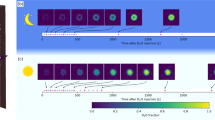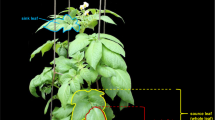Abstract
PREVIOUS work in inorganic solute movement in plants has suggested that the minerals follow a specific polar path from the roots which absorb them to the leaves in which they are deposited1,2. Recently, evidence supporting polar transport has been provided by Caldwell using a split root technique3. It was established that when the root systems were placed half in rich loam and half in sand the nutrient status of the two halves was reflected in the development of the foliage directly above. This result was interpreted as a polar movement of nutrients. However, the important issue is not whether polar movement can occur, but whether it must occur, owing to the absence of lateral transport systems.
This is a preview of subscription content, access via your institution
Access options
Subscribe to this journal
Receive 51 print issues and online access
$199.00 per year
only $3.90 per issue
Buy this article
- Purchase on Springer Link
- Instant access to full article PDF
Prices may be subject to local taxes which are calculated during checkout
Similar content being viewed by others
References
Biddulph, O., in Plant Physiology, 2, edit. by F. C. Steward (Academic Press, 1959).
Rinne, R. W., and Langston, R. G., Plant Physiol., 35, 216 (1960).
Caldwell, J., Nature, 190, 1028 (1961).
Author information
Authors and Affiliations
Rights and permissions
About this article
Cite this article
BAKER, D., MILBURN, J. Lateral Movement of Inorganic Solutes in Plants. Nature 205, 306–307 (1965). https://doi.org/10.1038/205306a0
Issue Date:
DOI: https://doi.org/10.1038/205306a0
This article is cited by
-
Sectorial root growth in cuttings of Coleus rehneltianus in response to localized aerial defoliation
Vegetatio (1996)
-
Induction of multiple root systems in apple seedlings by radicle splitting
Plant and Soil (1973)
-
Inhibition of water uptake by high concentrations of auxin-like substances
Biologia Plantarum (1970)
Comments
By submitting a comment you agree to abide by our Terms and Community Guidelines. If you find something abusive or that does not comply with our terms or guidelines please flag it as inappropriate.



